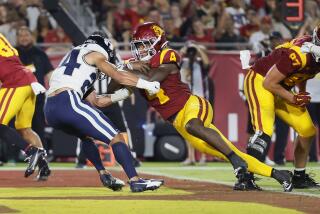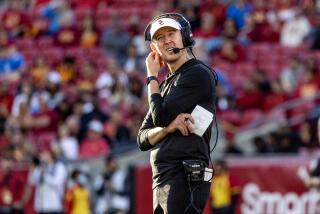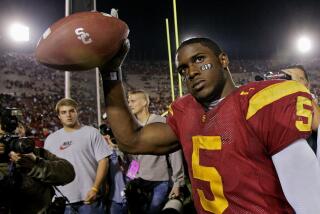Third and Long
- Share via
A missed field goal. A broken back. The fickleness of voters. Even a war.
Those are some of the circumstances that have thwarted college football teams that had opportunities to win three consecutive Associated Press national championships.
Unless or until USC loses a game -- and maybe even afterward, as long as hopes of another national championship are alive -- this piece of trivia is going to be mentioned often:
Nine previous teams won two AP titles in a row.
None won a third.
In the 1940s, Army and Notre Dame didn’t lose a game during the crucial third season but were dethroned by ties.
One team, Alabama, won in 1964 and ’65 and went undefeated and untied in 1966 and still didn’t three-peat.
And in the 1950s, Oklahoma won a major college-record 47 straight games under Bud Wilkinson, yet emerged with only the ’55 and ’56 titles.
“Bud’s team came the closest,” said Barry Switzer, whose own Sooner teams won consecutive AP titles in the 1970s. Switzer might get an argument, and in the time-honored, arbitrary and ever-evolving traditions of picking a major-college champion, that’s part of the game.
At Michie Stadium in West Point, N.Y., home to Army football since 1924, a sign on the upper deck reads “National Champions 1944 1945 1946” in honor of the three titles Army claims.
“If somebody wants to take it off, let them try. We’ve got a lot of MPs,” said Joe Steffy, the 1947 Outland Trophy winner who helped open holes for Heisman Trophy winners Glenn Davis and Felix “Doc” Blanchard.
Army won AP titles with undefeated seasons in 1944 and ‘45, then finished second to Notre Dame in ’46 when the teams played to a 0-0 tie in Yankee Stadium after a Notre Dame defensive back made a touchdown-saving tackle on Blanchard.
“It would have been terrible if I’d missed,” said Johnny Lujack, who won the Heisman the next season as Notre Dame’s quarterback.
Notre Dame went on to defeat USC in its final game -- the same day Army struggled to win against an underdog Navy team -- and AP was one of six organizations that designated the Irish No. 1. Three split the title, and two sided with Army outright.
“I never did understand how Notre Dame went on to be national champions when they just tied us,” Blanchard said. “We’d won the championship in ’44 and ’45. In boxing, you’ve got to beat the champ to be the champ.
“We were the champs.”
Notre Dame became the next team to be stopped short of a third AP title.
(Lujack completed a personal three-peat, interrupted only by World War II. He was on the ’43 Irish team that won the AP title, then spent two years in the Navy before returning to lead the Irish to the ’46 and ’47 titles.)
By 1948, Lujack was with the Chicago Bears, but Notre Dame remained undefeated going into a December game against USC at the Coliseum.
“We were having a bad day,” said Lujack’s replacement, Frank Tripucka, father of former NBA player Kelly Tripucka. “Guys who never fumbled were fumbling.”
It got worse. Late in the first half, Coach Frank Leahy ordered Tripucka to run a sneak, and he was hit hard by a defender.
Tripucka’s back was broken, and he remained in a Los Angeles hospital for several weeks, fearing at first he would be paralyzed.
“I was totally out of it. I was never in such pain in my life,” said Tripucka, who eventually recovered and went on to a long NFL career. “I didn’t hear until the next day we ended up in a tie.”
The 14-14 tie marred Notre Dame’s record and the ’48 title went to undefeated Michigan. Notre Dame missed out on a third consecutive championship -- or four in a row, if you consider that the Irish also won in ’49.
Wilkinson’s Sooners were unbeaten and untied in 1954, ’55 and ’56. But the ’54 team played a number of close games, and the AP title went to undefeated Ohio State. (The United Press International coaches’ poll chose unbeaten UCLA.)
Oklahoma’s streak ended in 1957 with a 7-0 loss to Notre Dame, and AP voters chose undefeated Auburn. UPI, which disqualified Auburn because it was on probation, chose once-beaten Ohio State.
“Had we not lost one ballgame our last year, we’d have been the first to get three,” said Clendon Thomas, an Oklahoma halfback who played from 1955 to ’57 and led the nation in scoring in 1956.
Alabama came close in the 1960s, going on a three-year run of 30-2-1 and winning AP titles in 1964 and ’65 -- but not in ‘66, when the Crimson Tide was 11-0.
Bear Bryant’s team had Ken Stabler and Ray Perkins, but it didn’t have the votes after No. 1 Notre Dame and No. 2 Michigan State played to a 10-10 tie in 1966 in one of those umpteen “games of the century.”
Late in the game, Notre Dame sat on the ball instead of trying to score -- in the minds of many, a calculation to avoid the possibility of losing the national championship coach Ara Parseghian believed the Irish would win even if they tied a game, but didn’t lose.
“We felt like they outvoted us up on the East Coast, but Coach Bryant wasn’t going to say anything. He had too much class,” said Clem Gryska, a longtime Bryant assistant who works at the Paul W. Bryant Museum in Tuscaloosa.
Alabama’s two-time champions finished at No. 3, despite an undefeated season.
Bryant’s one reported remark about the Notre Dame tactic: “At Alabama, we teach our men to win.”
Switzer doesn’t make much of his Oklahoma team’s chance to three-peat in ’76.
His undefeated ’74 team won the AP title, though it had to share the glory with 10-1-1 USC, the UPI choice, in part because the coaches’ poll didn’t include teams on probation.
The Sooners won again in ’75. But by ‘76, they had lost defensive stars Lee Roy and Dewey Selmon and changed quarterbacks and finished 9-2-1.
Until now, Nebraska was the most recent team with a chance for three AP titles in a row, when Coach Tom Osborne’s teams won the 1994 and ’95 titles with Brook Berringer and Tommie Frazier at quarterback and controversial Lawrence Phillips at running back.
Osborne -- now a U.S. congressman from Nebraska -- was sharply criticized for letting Phillips return to the team in ’95 after he’d been put on probation for assaulting a girlfriend. The trouble-prone running back -- arrested in Los Angeles last month after allegedly running a car into a crowd of teenagers near the Coliseum -- returned and led Nebraska to a second consecutive title with a 165-yard performance in the Fiesta Bowl.
Instead of controversy shattering the ’95 team, it might have kept attention sharp, said Turner Gill, a former Nebraska quarterback who was an assistant coach at the time.
“You have to be ready to play, and at no time can you feel sorry for yourselves if a player is hurt or someone is, for some reason, suspended,” Gill said.
The next year, the Cornhuskers no longer had Phillips or Frazier, and some players were grieving the loss of Berringer, killed in a plane crash in the spring of ’96.
In the second game of the season, Nebraska was stunned by Arizona State, 19-0. Even so, the Cornhuskers reached the Big 12 title game and would have had a chance to play for the national championship again if they had beaten Texas.
A missed opportunity to win three in a row isn’t always the year after back-to-back championships. Sometimes, it’s the year before.
In 1993, Nebraska lost the national championship to Florida State in the Orange Bowl, 18-16, only after missing a 45-yard field-goal attempt on the final play, less than 30 seconds after the Seminoles had shaken off their field-goal jinx and made a short kick for a two-point lead.
“Four opportunities to be national champs,” Gill said. “Then we came back in ’97 and won [the USA Today/ESPN title], so really in four out of five years, we played for the national championship.”
Now it is USC’s turn to try to make what will be called history if the Trojans can win a third consecutive AP title after splitting the 2003 national championship with BCS champion Louisiana State and taking the consensus title last season while undefeated Auburn and Utah watched from the outside.
In the nearly 70 years since the AP poll made its debut, many teams have claimed many titles, but no team has won three AP championships in a row.
Consider Minnesota.
The Golden Gophers won in 1940 and ‘41, with back-to-back undefeated seasons.
Then came Dec. 7, 1941.
“World War II had started,” said Richard Wildung, a Minnesota tackle from 1940 to ’42. “I don’t think we were thinking about a national championship.”
The team’s coach, Bernie Bierman, spent the next three years as a lieutenant colonel in the Marines. Many players joined the service too.
“We just had what we had left over,” Wildung said.
Minnesota went 5-4 in 1942, its chance at a third national championship an insignificant casualty of war.
Yet if USC wins a third consecutive title, people should remember the Minnesota teams of another era.
The Golden Gophers won the first AP title in 1936.
They also had been champions in 1934 and ’35.
The AP poll just didn’t exist to crown them.
*
Times staff writer David Wharton contributed to this report.
*
(BEGIN TEXT OF INFOBOX)
In charm’s way
USC is the 10th team to win consecutive Associated Press national championships. None of the previous nine won a third in a row. Teams and title years with their record the following season:
*--* Team Title Years Record AP Finish AP Champion NEBRASKA 1994-95 11-2 6 Florida (12-1) ALABAMA 1978-79 10-2 6 Georgia (12-0) OKLAHOMA 1974-75 9-2-1 5 Pittsburgh (12-0) NEBRASKA 1970-71 9-2-1 4 USC (12-0) ALABAMA 1964-65 11-0 3 Notre Dame (9-0-1) OKLAHOMA 1955-56 10-1 4 Auburn (10-0) NOTRE DAME 1946-47 9-0-1 2 Michigan (9-0) ARMY 1944-45 9-0-1 2 Notre Dame (8-0-1) MINNESOTA 1940-41 5-4 19 Ohio State (9-1)
*--*
More to Read
Fight on! Are you a true Trojans fan?
Get our Times of Troy newsletter for USC insights, news and much more.
You may occasionally receive promotional content from the Los Angeles Times.






